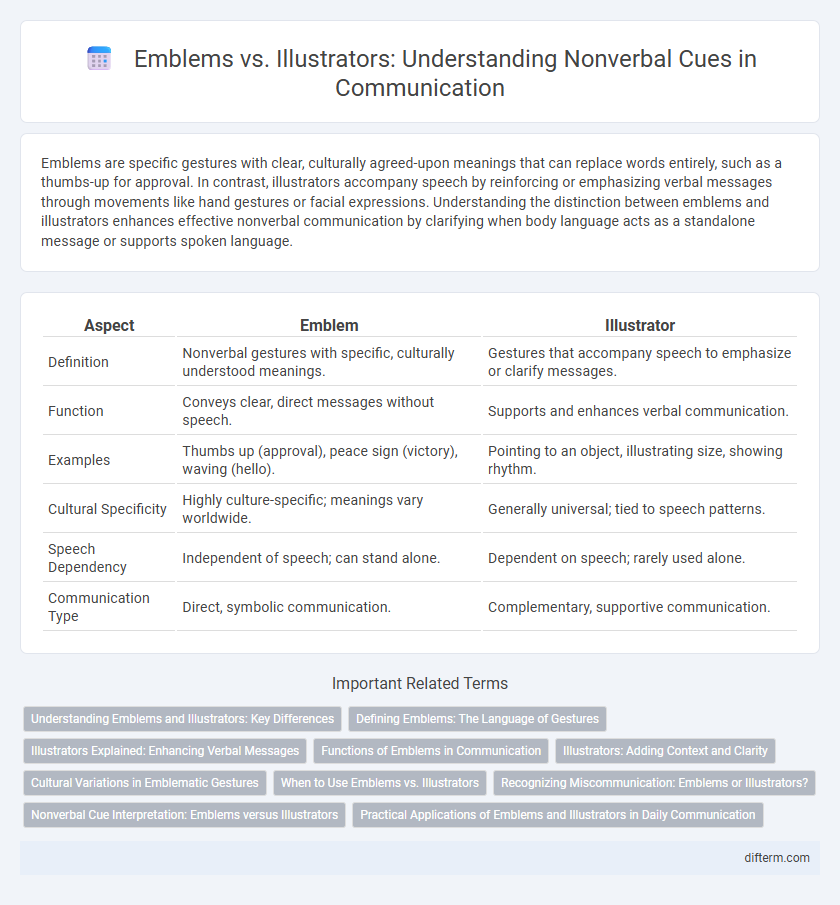Emblems are specific gestures with clear, culturally agreed-upon meanings that can replace words entirely, such as a thumbs-up for approval. In contrast, illustrators accompany speech by reinforcing or emphasizing verbal messages through movements like hand gestures or facial expressions. Understanding the distinction between emblems and illustrators enhances effective nonverbal communication by clarifying when body language acts as a standalone message or supports spoken language.
Table of Comparison
| Aspect | Emblem | Illustrator |
|---|---|---|
| Definition | Nonverbal gestures with specific, culturally understood meanings. | Gestures that accompany speech to emphasize or clarify messages. |
| Function | Conveys clear, direct messages without speech. | Supports and enhances verbal communication. |
| Examples | Thumbs up (approval), peace sign (victory), waving (hello). | Pointing to an object, illustrating size, showing rhythm. |
| Cultural Specificity | Highly culture-specific; meanings vary worldwide. | Generally universal; tied to speech patterns. |
| Speech Dependency | Independent of speech; can stand alone. | Dependent on speech; rarely used alone. |
| Communication Type | Direct, symbolic communication. | Complementary, supportive communication. |
Understanding Emblems and Illustrators: Key Differences
Emblems are nonverbal gestures with a specific, widely recognized meaning, such as a thumbs-up symbolizing approval, and can stand alone without verbal communication. Illustrators accompany speech to clarify or emphasize verbal messages, like using hand movements to indicate size or direction, enhancing the listener's understanding. Recognizing the key difference between emblems and illustrators helps improve communication effectiveness by accurately interpreting intentional nonverbal cues.
Defining Emblems: The Language of Gestures
Emblems are culturally specific nonverbal gestures that convey precise meanings without spoken words, such as a thumbs-up signaling approval or a wave indicating hello. Unlike illustrators, which complement verbal communication by visually reinforcing spoken messages, emblems function independently as complete semantic units understood within a cultural context. These gestures serve as a distinct language of gestures, enabling direct communication through body language across diverse interpersonal and social interactions.
Illustrators Explained: Enhancing Verbal Messages
Illustrators are nonverbal cues that complement and emphasize spoken words, such as hand gestures or facial expressions that synchronize with verbal messages to clarify meaning. Unlike emblems, which have specific, culturally understood meanings, illustrators vary in form and function depending on the context and speaker's intent. These gestures enhance communication by visually reinforcing the verbal message, increasing listener comprehension and engagement.
Functions of Emblems in Communication
Emblems serve as nonverbal cues that convey specific messages without speech, functioning as culturally recognized symbols like waving to mean hello or thumbs-up to indicate approval. These gestures facilitate efficient communication by providing clear, universally understood signals that reduce ambiguity in interactions. Emblems play a vital role in bridging language barriers and enhancing the expressiveness of social exchanges.
Illustrators: Adding Context and Clarity
Illustrators serve as essential nonverbal cues that enhance verbal communication by visually emphasizing or clarifying spoken words, such as hand movements illustrating size or direction. Unlike emblems, which have fixed, culturally specific meanings, illustrators dynamically complement speech, making messages more understandable and engaging. Their synchronized use with language improves cognitive processing and retention of information in conversations.
Cultural Variations in Emblematic Gestures
Emblematic gestures vary significantly across cultures, with a specific gesture in one culture potentially having a completely different or even offensive meaning in another. For example, the thumbs-up sign is positive in many Western countries but considered rude in parts of the Middle East and West Africa. Understanding these cultural variations in emblems is crucial for effective nonverbal communication and avoiding misunderstandings in intercultural interactions.
When to Use Emblems vs. Illustrators
Emblems are ideal for conveying clear, culturally recognized messages without speech, such as waving to say hello or thumbs up for approval, making them effective in noisy environments or when verbal communication is impractical. Illustrators complement verbal messages by visually emphasizing or clarifying spoken words, like using hand gestures to describe size or direction, enhancing listener comprehension during conversations. Choosing between emblems and illustrators depends on whether the goal is to replace words with universally understood signs or to support and enrich spoken communication with visual cues.
Recognizing Miscommunication: Emblems or Illustrators?
Emblems are culturally specific nonverbal cues that carry explicit verbal meanings, making them less prone to misinterpretation in cross-cultural communication. Illustrators complement verbal messages by emphasizing or clarifying spoken words, but their ambiguous nature increases the risk of miscommunication. Recognizing whether a gesture functions as an emblem or an illustrator is essential for accurately interpreting nonverbal signals and preventing misunderstandings.
Nonverbal Cue Interpretation: Emblems versus Illustrators
Emblems are nonverbal cues that have specific, culturally recognized meanings and can replace verbal messages, such as a thumbs-up signaling approval. Illustrators complement or emphasize spoken language by adding visual context, like using hand movements to describe the size or shape of an object. Accurate interpretation of emblems requires understanding cultural norms, while illustrators depend on the interplay between verbal and nonverbal communication for clarity.
Practical Applications of Emblems and Illustrators in Daily Communication
Emblems such as the thumbs-up gesture convey specific meanings universally understood within cultural contexts, facilitating concise and clear nonverbal communication. Illustrators, like hand movements accompanying speech, emphasize or clarify verbal messages to enhance listener comprehension in everyday interactions. Practical use of emblems and illustrators improves communication efficiency by reducing misunderstandings and reinforcing spoken language without relying on words.
emblem vs illustrator (nonverbal cues) Infographic

 difterm.com
difterm.com